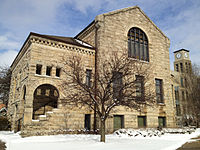John Baldwin (educator)
John Baldwin | |
|---|---|
 John Baldwin | |
| Born | October 13, 1799 Branford, Connecticut, U.S. |
| Died | December 28, 1884 (aged 85) Baldwin, Louisiana, U.S. |
| Spouse | Mary Chappel |
John Baldwin (October 13, 1799 – December 28, 1884) was an American educator, and the founder of Baldwin Institute (later Baldwin University) in
Born in Connecticut, Baldwin originally was a teacher in Maryland and Connecticut before moving to Ohio in the late 1820s. He became part of the lyceum movement and situated himself in Berea, Ohio. He opened up Baldwin Institute in 1846 upon seeing the dissolution of the Norwalk Seminary. Nine years later, the Institute became Baldwin University. He moved to Kansas around 1857, laying the foundation for Baldwin City, Kansas, as well as Baker University. In his later life, he purchased a Louisiana plantation and made contributions to education in India late in his life.
Biography
Early life
John Baldwin was born in
Founding Berea

After marrying Mary Chappel on January 31, 1828, they moved to Middleburg Township in
Baldwin Institute
In 1843, Baldwin noticed that the Norwalk Seminary, located in
Life in Kensett, Iowa
At age fifty-eight, Baldwin desired to satisfy his nature of being a pioneer again by moving to Kansas, which was at that time a territory. He arrived as the brunt of the fighting in the territory was ending. Upon his arrival, he founded
Later years & family legacy


In 1867, Baldwin purchased the Darby plantation in
Personal views
John Baldwin was a person whose views seemed to run counter to the conventional customs of the time.
Notes
- ^ Baldwin, Charles Candee (1880). Baldwin Genealogy. Cleveland, Ohio. p. 996.
{{cite book}}: CS1 maint: location missing publisher (link) - ^ Webber 1925, p. 16.
- ^ a b Webber 1925, p. 27.
- ^ Webber 1925, p. 28.
- ^ Webber 1925, p. 43.
- ^ Webber 1925, pp. 45–46<.
- ^ Webber 1925, p. 50.
- ^ a b Webber 1925, p. 64.
- ^ "City of Berea Ohio USA". Archived from the original on October 23, 2007. Retrieved 2007-07-21.
- ^ Webber 1925, p. 103.
- ^ Markham, 88
- ^ Webber 1925, p. 104.
- ^ Webber 1925, p. 139.
- ^ Webber 1925, p. 167.
- ^ Webber 1925, p. 171.
- ^ a b c Assad, Mary (2008). Baldwin-Wallace College. Arcadia. p. 21.
- ^ Assad, Mary (2008). Baldwin-Wallace College. Arcadia. p. 102.
- ^ White Rose Ceremony. "White Rose Ceremony History". Baldwin Wallace College. Archived from the original on 22 February 2012. Retrieved 4 March 2012.
- ^ a b Webber 1925, p. 11.
- ^ Webber 1925, p. 20.
References
- Baldwin, Charles Candee. Baldwin Genealogy, 1880.
- Clary, Norman J. Baldwin–Wallace College. Cradles of Conscience. Ed. John Wiliam Oliver, Jr. Kent State University Press, 2003. 39–51 ISBN 0-87338-763-5
- Markham, Virginia Gatch. John Baldwin and son Milton come to Kansas: an early history of Baldwin City, Baker University, and Methodism in Kansas. Baldwin City, Kansas. The University, 1982.
- OCLC 664171.
External links

